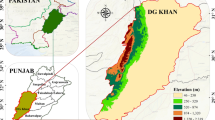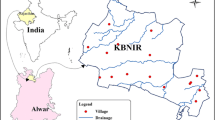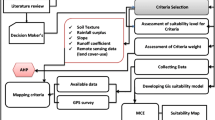Abstract
The watershed under investigation is located in northeast Libya and lies in arid (downstream) and semi-arid (upstream) regions with an aerial extent of 1511 km2. Rainfed agriculture and grazing form the regular economic activities of the local community, and they face challenges related to scarce water resources and soil loss due to less rainfall and higher runoff and evaporation. Exploiting Rainwater Harvesting (RWH) is one of the most promising solutions to these challenges. In this study, remote sensing (RS) and geographic information system (GIS) approaches have been employed in assessing the potential surface water and identifying potential RWH sites, which are both critical tasks for effective water resource management. The runoff was estimated using Soil Conservation Service Curve Number (SCS-CN) method, where the CN is computed by the LULC map generated from Landsat 8 OLI imagery that was intersected with the HSG layer. Moreover, due to the unavailability of rainfall data in the study area, the precipitation data from Multi-satellite Retrievals for Global Precipitation Measurement (IMERG GPM) was used in the runoff calculation, where the average ten-year runoff volume was estimated as 26.5 Mm3. The RWH suitability sites were delineated based on the Analytical Hierarchy Process (AHP) method, where the criteria selection was performed based on a literature review, followed by weighted overlay analysis to determine the layer of suitable sites. The results showed that optimal and suitable sites cover 2.5% and 9% of the watershed, while the rest of the watershed is covered by moderate, marginal, and unsuitable sites covering 17.7%, 25%, and 45.7%, respectively. The watershed is found to have the potential to support RWH for soil and water conservation. Also, the RWH structures map was generated according to the indigenous dominant types.
Access this chapter
Tax calculation will be finalised at checkout
Purchases are for personal use only
Similar content being viewed by others
References
ACSAD (2005) Soil Terrain digital database (Libyan SOTER,2005). Arab Center for the Studies of Arid Zones and Dry Lands
Adham A, Sayl KN, Abed R, Abdeladhim MA, Wesseling JG, Riksen M, Fleskens L, Karim U, Ritsema CJ (2018) A GIS-based approach for identifying potential sites for harvesting rainwater in the Western Desert of Iraq. Int Soil Water Conserv Res 6(4):297–304. https://doi.org/10.1016/j.iswcr.2018.07.003
Ahmad I, Verma MK (2018) Application of analytic hierarchy process in water resources planning: a GIS based approach in the identification of suitable site for water storage. Water Resour Manag 32:5093–5114. https://doi.org/10.1007/s11269-018-2135-x
Al-Adamat R, AlAyyash S, Al-Amoush H, Al-Meshan O, Rawajfih Z, Shdeifat A, Al-Harahsheh A, Al-Farajat M (2012) The combination of indigenous knowledge and geo-informatics for water harvesting siting in the Jordanian Badia. J Geogr Inf Syst 4(4):366–376. https://doi.org/10.4236/jgis.2012.44042
Allan JA, McLachlan KS, Edith. (1975) Libya: agriculture and economic development. Am Geograp Soc 65(1):128–129
Alwan IA, Aziz NA, Hamoodi MN (2020) Potential water harvesting sites identification using spatial multi-criteria evaluation in Maysan Province, Iraq. ISPRS Int J Geo-Info 9(4):235. https://doi.org/10.3390/ijgi9040235
Ammar A, Riksen M, Ouessar M, Ritsema C (2016) Identification of suitable sites for rainwater harvesting structures in arid and semi-arid regions: a review. Int Soil Water Conserv Res 4(2):108–120. https://doi.org/10.1016/j.iswcr.2016.03.001
Amutha R, Porchelvan P (2009) Estimation of surface runoff in malattar sub-watershed using SCS-cn method. J Indian Soc Remote Sensing 37:291. https://doi.org/10.1007/s12524-009-0017-7
Arlab (1983) Complementary investigation of surface water, groundwater, and climatological survey in Southern Flanks of Al Jabal Al Akhdar. Secretariat of Agriculture Land ReclamationSecretariat of Agriculture Land Reclamation. Tripoli-Libya
Badhe Y, Medhe R, Shelar T (2020) Site suitability analysis for water conservation using AHP and GIS techniques: a case study of upper Sina River catchment, Ahmednagar (India). Hydrospatial Anal 3(2):49–59. https://doi.org/10.21523/gcj3.19030201
Bakir M, **ngnan Z (2008) GIS and remote sensing applications for rainwater harvesting in the Syrian Desert(Al-Badia). In: Proceedings of twelfth international water technology conference, IWTC12, Alexandria, pp 73–82
Bhat MS, Alam A, Ahmad S, Farooq H, Ahmad B (2019) Flood hazard assessment of upper Jhelum basin using morphometric parameters. Environ Earth Sci 78:54. https://doi.org/10.1007/s12665-019-8046-1
Blanco-Canqui H, Lal R (2010) Principles of soil conservation and management. https://doi.org/10.1007/978-1-4020-8709-7
Boers TM (1994) Rainwater harvesting in Arid and Semi-Arid Zones. Agricultural University. Promotor(en): R.A. Feddes. - Wageningen: ILRI - ISBN 9789070754365 - 133
Buraihi FH, Shariff ARM (2015) Selection of rainwater harvesting sites by using remote sensing and GIS techniques: a case study of Kirkuk, Iraq. Jurnal Teknol 76(15). https://doi.org/10.11113/jt.v76.5955
Chopra R, Dhiman RD, Sharma PK (2005) Morphometric analysis of sub-watersheds in Gurdaspur district, Punjab using remote sensing and GIS techniques. J Indian Soc Remote Sensing 33:531. https://doi.org/10.1007/BF02990738
Congedo L (2016) Semi-automatic classification plugin semi-automatic classification plugin documentation. Technical Report. https://doi.org/10.13140/RG.2.2.29474.02242/1
De Coning E, Poolman E (2011) South African weather service operational satellite based precipitation estimation technique: applications and improvements. Hydrol Earth Syst Sci 15(4):1131–1145. https://doi.org/10.5194/hess-15-1131-2011
Dingman SL (1978) Drainage density and streamflow: a closer look. Water Resour Res 14(6):1183–1187. https://doi.org/10.1029/WR014i006p01183
Dunjó G, Pardini G, Gispert M (2004) The role of land use-land cover on runoff generation and sediment yield at a microplot scale, in a small Mediterranean catchment. J Arid Environ 57(2):239–256. https://doi.org/10.1016/S0140-1963(03)00097-1
ESRI (2016) Geoprocessing tool reference. Online; Environmental Systems Research Institute. https://desktop.arcgis.com/en/arcmap/10.3/tools/spatial-analyst-toolbox/an-overview-of-the-hydrology-tools.htm
Fick SE, Hijmans RJ (2017) WorldClim 2: new 1-km spatial resolution climate surfaces for global land areas. Int J Climatol 37(12):4302–4315. https://doi.org/10.1002/joc.5086
Frnlab (1974) Water resources study of Southern Flanks of Al Jabal Al Akhdar Phase I. Libyan Secretariat of Agriculture Land ReclamationSecretariat of Agriculture Land Reclamation. Tripoli-Libya
Frnlab (1976) Water resources study of Southern Flanks of Al Jabal Al Akhdar Phase I. Libyan Secretariat of Agriculture Land ReclamationSecretariat of Agriculture Land Reclamation. Tripoli-Libya
Gado TA, Hsu K, Sorooshian S (2017) Rainfall frequency analysis for ungauged sites using satellite precipitation products. J Hydrol 554:646–655. https://doi.org/10.1016/j.jhydrol.2017.09.043
García-Ruiz JM (2010) The effects of land uses on soil erosion in Spain: a review. Catena 81(1):1–11. https://doi.org/10.1016/j.catena.2010.01.001
Gilewski P, Nawalany M (2018) Inter-comparison of rain-gauge, radar, and satellite (IMERG GPM) precipitation estimates performance for rainfall-runoff modeling in a mountainous catchment in Poland. Water (Switzerland) 10(11):1–23. https://doi.org/10.3390/w10111665
Glendenning CJ, Van Ogtrop FF, Mishra AK, Vervoort RW (2012) Balancing watershed and local scale impacts of rain water harvesting in India - a review. Agric Water Manag 107:1–13. https://doi.org/10.1016/j.agwat.2012.01.011
Goyal RK, Khan MA, Bhati TK et al (2013) Watershed Management for Development of hot arid zone of India. Arid Zone Res Inst Jodhpur India 003:46
GWA (2006) Water resources status of Libya.General Water Authority. Tripoli-Libya
Hamad S (2019) Spatial characteristics of the southern Al Jabal Al Akhdar watersheds: remote sensing approach. Hydrospatial Anal 3(1):37–48. https://doi.org/10.21523/gcj3.19030104
Hassanli AM, Beecham S (2013) Criteria for optimizing check dam location and maintenance requirements. In Check Dams, morphological adjustments and erosion control in torrential stream, pp 11–31
Horton RE (1945) Erosional development of streams and their drainage basins: Hydrophysical approach to quantitative morphology. Bull Geol Soc Am. https://doi.org/10.1130/0016-7606(1945)56[275:EDOSAT]2.0.CO;2
Huffman GJ, Stocker EF, Bolvin DT, Nelkin EJ, Jackson T (2019) GPM IMERG early precipitation L3 half hourly 0.1 degree x 0.1 degree V06. Goddard Earth Sciences Data and Information Services Center (GES DISC). https://doi.org/10.5067/GPM/IMERG/3B-HH-E/06
Ibrahim GRF, Rasul A, Hamid AA, Ali ZF, Dewana AA (2019) Suitable site selection for rainwater harvesting and storage case study using Dohuk governorate. Water (Switzerland) 1(4):864. https://doi.org/10.3390/w11040864
IRC (1974) Geological maps of Libya. Industrial Research Center
Kadam A, Karnewar AS, Umrikar B, Sankhua RN (2019) Hydrological response-based watershed prioritization in semiarid, basaltic region of western India using frequency ratio, fuzzy logic and AHP method. Environ Dev Sustain 21(4):1809–1833. https://doi.org/10.1007/s10668-018-0104-4
Konar M (2007) Rainwater harvesting in rural India - Taankas in the Thar Desert. Waterlines 25(4):22–24. https://doi.org/10.3362/0262-8104.2007.022
Krois J, Schulte A (2014) GIS-based multi-criteria evaluation to identify potential sites for soil and water conservation techniques in the Ronquillo watershed, northern Peru. Appl Geogr 51:131–142. https://doi.org/10.1016/j.apgeog.2014.04.006
Lucas-Borja ME, Zema DA, Antonio Plaza-álvarez P, Zupanc V, Baartman J, Sagra J, González-Romero J, Moya D, de las Heras, J. (2019) Effects of different land uses (abandoned farmland, intensive agriculture and forest) on soil hydrological properties in southern Spain. Water (Switzerland) 11(3):503. https://doi.org/10.3390/w11030503
Mahmood K, Qaiser A, Farooq S, Nisa M, un. (2020) RS- and GIS-based modeling for optimum site selection in rain water harvesting system: an SCS-CN approach. Acta Geophys 68(4):1175–1185. https://doi.org/10.1007/s11600-020-00460-x
Malczewski J (1999) GIS and multicriteria decision analysis (Vol. 1). Wiley. https://www.wiley.com/en-us/GIS+and+Multicriteria+Decision+Analysis-p-9780471329442
Martín-Moreno C, Martín Duque JF, Nicolau Ibarra JM, Hernando Rodríguez N, Sanz Santos MÁ, Sánchez Castillo L (2016) Effects of topography and surface soil cover on erosion for mining reclamation: the experimental spoil heap at El Machorro mine (Central Spain). Land Degrad Dev 27(2):145–159. https://doi.org/10.1002/ldr.2232
Matomela N, Tianxin L, Morahanye L, Bishoge OK, Ikhumhen HO (2019) Rainfall-runoff estimation of Bojiang lake watershed using SCS-CN model coupled with GIS for watershed management. J Appl Adv Res 4(1):16. https://doi.org/10.21839/jaar.2019.v4i1.263
Matomela N, Li T, Ikhumhen HO (2020) Siting of rainwater harvesting potential sites in arid or semi-arid watersheds using GIS-based techniques. Environ Proces 7(2020):631–652. https://doi.org/10.1007/s40710-020-00434-7
Mishra SK, Singh VP (2003) Soil conservation service curve number (SCS-CN) methodology. Water Sci Technol Library. https://doi.org/10.1007/978-94-017-0147-1
Mugo GM, Odera PA (2019) Site selection for rainwater harvesting structures in Kiambu County-Kenya. Egyptian J Remote Sensing Space Sci 22(2):155–164. https://doi.org/10.1016/j.ejrs.2018.05.003
Nayak RR, Krishnaswamy J, Vaidyanathan S (2020) Exotic plantations increase risks of flooding in mountainous landscapes. pp. 1–25. https://doi.org/10.1002/essoar.10503675.2
Nganga BW, Ngetich KO, Adamtey N, Milka K, Ngetich KF (2019) Application of GIS on the identification of suitable areas for water conservation Technologies in the Upper Tana Watershed of the central highlands of Kenya. Int J Plant Soil Sci 30(1):1–20. https://doi.org/10.9734/ijpss/2019/v30i130166
NRCS (1986) Urban hydrology for small watersheds (Natural Resources Conservation Service (ed.); 2nd ed.). USDA.United States Department Agriculture
Nunes AN, de Almeida AC, Coelho COA (2011) Impacts of land use and cover type on runoff and soil erosion in a marginal area of Portugal. Appl Geogr 31(2):687–699. https://doi.org/10.1016/j.apgeog.2010.12.006
Odhiambo GO (2017) Water scarcity in the Arabian Peninsula and socio-economic implications. Appl Water Sci 7(5):2479–2492. https://doi.org/10.1007/s13201-016-0440-1
OMU (2005) Studying and evaluating the natural vegetation in Al-Jabal Al-Akhdar area (In Arabic), Omer Al Mukhtar University
Oweis TY, Prinz D, Hachum AY (2012) Rainwater harvesting for agriculture in the dry areas. In Rainwater harvesting for agriculture in the Dry Areas. https://doi.org/10.1201/b12351
Pallard B, Castellarin A, Montanari A (2009) A look at the links between drainage density and flood statistics. Hydrol Earth Syst Sci 13(2009):1019–1029. https://doi.org/10.5194/hess-13-1019-2009
Peng J, Dadson S, Hirpa F, Dyer E, Lees T, Miralles DG, Vicente-Serrano SM, Funk C (2020) A pan-African high-resolution drought index dataset. Earth Syst Sci Data 12(2020):753–769. https://doi.org/10.5194/essd-12-753-2020
Ragab R, Prudhomme C (2002) Climate change and water resources management in arid and semi-arid regions: prospective and challenges for the 21st century. Biosyst Eng 81(1):3–34. https://doi.org/10.1006/bioe.2001.0013
Rahmati O, Kalantari Z, Samadi M, Uuemaa E (2019) GIS-based site selection for check dams in watersheds: considering Geomorphometric and Topo-hydrological factors. Sustainability 11(5639). https://doi.org/10.3390/su11205639
Rai PK, Mohan K, Mishra S, Ahmad A, Mishra VN (2017) A GIS-based approach in drainage morphometric analysis of Kanhar River Basin, India. Appl Water Sci 7(2017):217–232. https://doi.org/10.1007/s13201-014-0238-y
Rikalovic A, Cosic I, Lazarevic D (2014) GIS based multi-criteria analysis for industrial site selection. Procedia Eng 69(2014):1054–1063. https://doi.org/10.1016/j.proeng.2014.03.090
Rodhe A (2012) Physical models for classroom teaching in hydrology. Hydrol Earth Syst Sci 16:3075–3082. https://doi.org/10.5194/hess-16-3075-2012
Saaty TL (2008) Decision making with the analytic hierarchy process. Int J Serv Sci 1(83). https://doi.org/10.1504/IJSSCI.2008.017590
Sayl KN, Muhammad NS, El-Shafie A (2019) Identification of potential sites for runoff water harvesting. Proc Inst Civil Eng Water Manag 172(3):135–148. https://doi.org/10.1680/jwama.16.00109
SELKHOZPROMEXPORT (1980) Soil studies in the Eastern Zone of the socialist people. Agricultural Reclamation and Land Development, SPLAJ. VNESHTORGREKLAMA" Publishing House, USSR
Șen Z (2008) Wadi Hydrology. CRC Press, Boca Raton. https://doi.org/10.1201/9781420061550
Shadmehri Toosi A, Ghasemi Tousi E, Ghassemi SA, Cheshomi A, Alaghmand S (2020) A multi-criteria decision analysis approach towards efficient rainwater harvesting. J Hydrol 582(2020):124501. https://doi.org/10.1016/j.jhydrol.2019.124501
Shalamzari MJ, Zhang W, Gholami A, Zhang Z (2019) Runoff harvesting site suitability analysis for wildlife in sub-desert regions. Water (Switzerland) 11:1944. https://doi.org/10.3390/w11091944
Sindhu D, Shivakumar BL, Ravikumar AS (2013) Estimation of surface runoff in Nallur Amanikere. Int J Res Eng Technol 2(13):404–409
Smith KG (1950) Standards for grading texture of erosional topography. Am J Sci. https://doi.org/10.2475/ajs.248.9.655
Soo EZX, Wan Jaafar WZ, Lai SH, Othman F, Elshafie A, Islam T, Srivastava P, Othman Hadi HS (2020) Precision of raw and bias-adjusted satellite precipitation estimations (TRMM, IMERG, CMORPH, and PERSIANN) over extreme flood events: case study in Langat river basin, Malaysia. J Water Climate Change jwc2020180:1–21. https://doi.org/10.2166/wcc.2020.180
Stec A, Kordana S (2015) Analysis of profitability of rainwater harvesting, gray water recycling and drain water heat recovery systems. Resour Conserv Recycl 105(A):84–94. https://doi.org/10.1016/j.resconrec.2015.10.006
Strahler A (1964) Quantitative geomorphology of drainage basins and channel networks. In: Chow E, V. (eds) Handbook of applied hydrology. McGraw Hill, New York, pp 439–476
USDA (2004) Hydrologic soil-cover complexes Part 630. In Hydrology national engineering handbook. United States Department of Agriculture. p. 20
USDA (2009) Hydrologic soil groups. In National engineering handbook. The U.S. Department of Agriculture (USDA). p. 13
USGS (2000) EROS archive - Digital elevation - Shuttle Radar Topography Mission (SRTM) 1 Arc-Second Global. Earth Resources Observation and Science (EROS) Center. https://doi.org/10.5066/F7PR7TFT
USGS (2013) USGS EROS Archive - Landsat Archives - Landsat 8 OLI (Operational Land Imager) and TIRS (Thermal Infrared Sensor) Level-1 Data Products. Earth Resources Observation and Science (EROS) Center. https://doi.org/10.5066/F71835S6
Viji R, Prasanna PR, Ilangovan R (2015) Gis based SCS - CN method for estimating runoff in Kundahpalam watershed, Nilgries District, Tamilnadu. Earth Sciences Research Journal 19(1):59–64. https://doi.org/10.15446/esrj.v19n1.44714
Wu RS, Molina GLL, Hussain F (2018) Optimal sites identification for rainwater harvesting in Northeastern Guatemala by analytical hierarchy process. Water Resour Manag 32(12):4139–4153. https://doi.org/10.1007/s11269-018-2050-1
Zeng QL, Yue ZQ, Yang ZF, Zhang XJ (2009) A case study of long-term field performance of check-dams in mitigation of soil erosion in Jiangjia stream, China. Environ Geol 58(4):897–911. https://doi.org/10.1007/s00254-008-1570-z
Author Contributions
Salah Hamad: conceptualization, methodology, software, data collection, spatial analysis, interpretation, writing-original draft, modeling, assessment, field investigation. Nilanchal Patel: review and editing. All authors have read and agreed to the published version of the manuscript.
Author information
Authors and Affiliations
Corresponding author
Editor information
Editors and Affiliations
Rights and permissions
Copyright information
© 2022 The Author(s), under exclusive license to Springer Nature Switzerland AG
About this chapter
Cite this chapter
Hamad, S., Patel, N. (2022). Surface Water Potential and Suitable Sites Identification for RWH in the Semi-Arid and Arid Watershed of Wadi Sammalus, Northeast Libya Using GIS and Remote Sensing Approach. In: Zurqani, H.A. (eds) Environmental Applications of Remote Sensing and GIS in Libya. Springer, Cham. https://doi.org/10.1007/978-3-030-97810-5_8
Download citation
DOI: https://doi.org/10.1007/978-3-030-97810-5_8
Published:
Publisher Name: Springer, Cham
Print ISBN: 978-3-030-97809-9
Online ISBN: 978-3-030-97810-5
eBook Packages: Earth and Environmental ScienceEarth and Environmental Science (R0)




